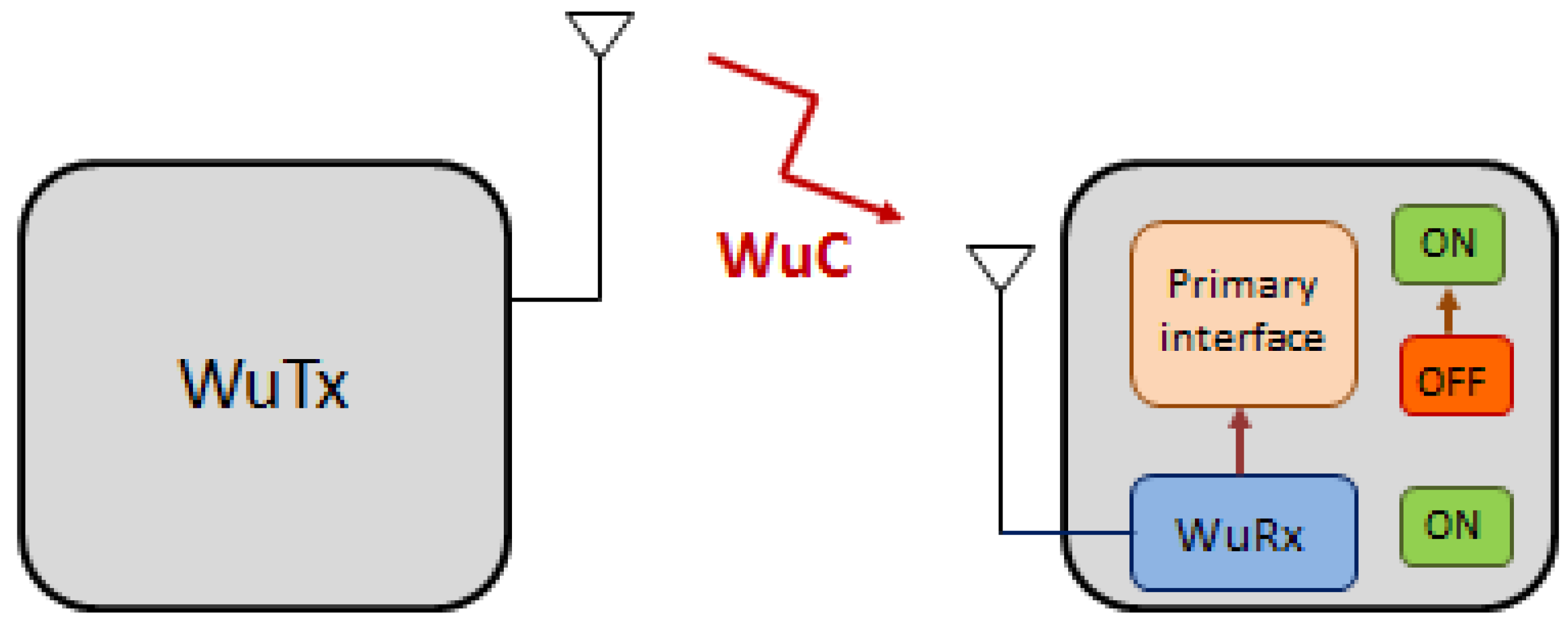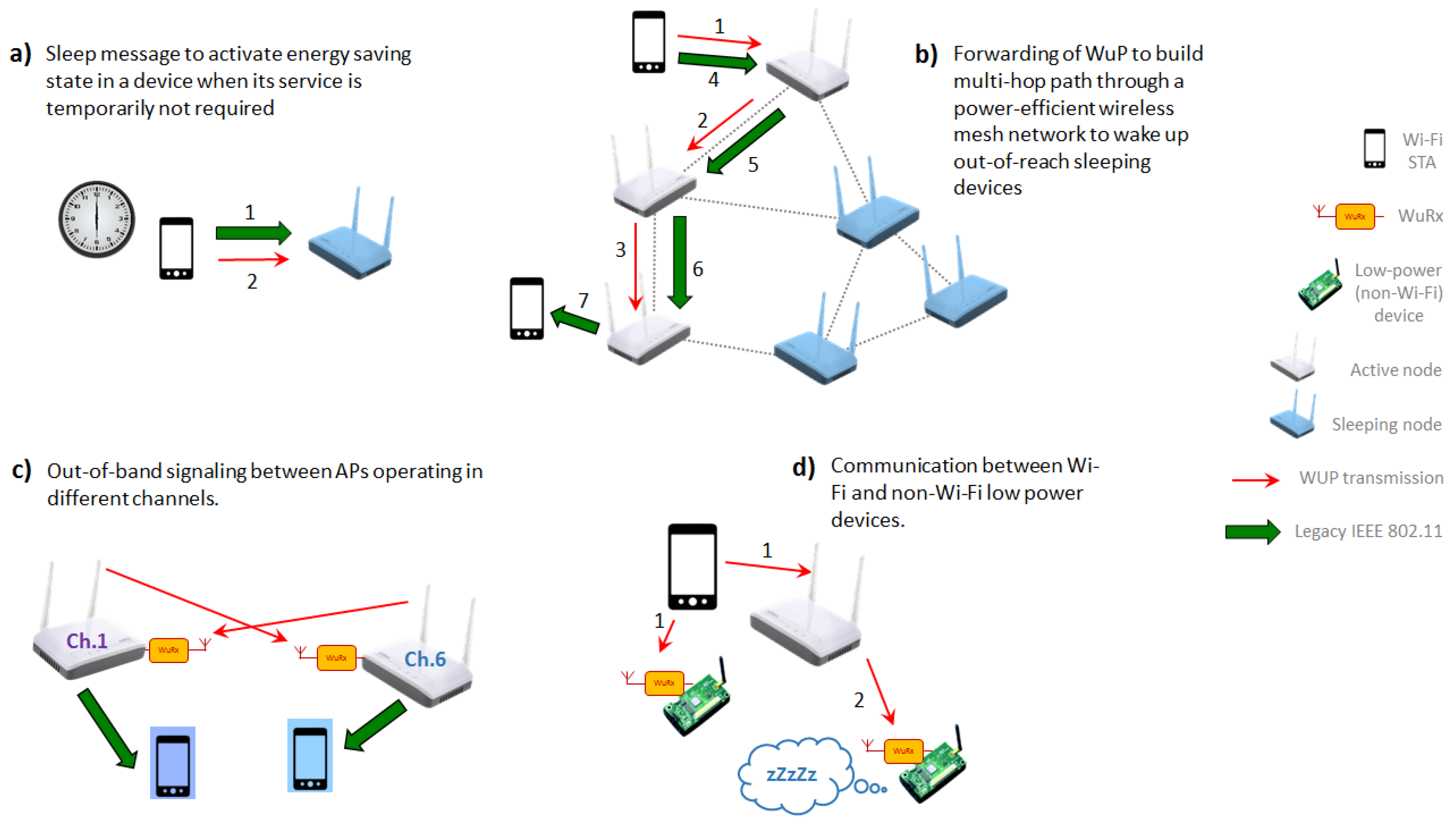IEEE 802.11-Enabled Wake-Up Radio: Use Cases and Applications
Abstract
1. Introduction
2. Wake-Up Radio Systems So Far
IEEE 802.11-Based WuR Solutions
3. IEEE 802.11ba Amendment
3.1. Usage Models
3.2. PHY and MAC Characteristics
4. A Proof-Of-Concept IEEE 802.11-Based WuR Implementation
4.1. IEEE 802.11 as WuR Technology
4.2. Proof-Of-Concept: Wi-Fi Controlled Smart Plug
5. Beyond Wake-Up Functionality
6. Conclusions
Author Contributions
Funding
Conflicts of Interest
References
- Espressif Systems. ESP32 Datasheet, Version 2.1. 2018. Available online: https://www.espressif.com/sites/default/files/documentation /esp32_datasheet_en.pdf (accessed on 20 December 2019).
- Texas Instruments. CC2630 SimpleLink 6LoWPAN, ZigBee Wireless MCU Datasheet (Rev. B). 2016. Available online: http://www.ti.com/lit/ds/symlink/cc2630.pdf (accessed on 20 December 2019).
- Piyare, R.; Murphy, A.L.; Kiraly, C.; Tosato, P.; Brunelli, D. Ultra Low Power Wake-Up Radios: A Hardware and Networking Survey. IEEE Commun. Surv. Tutor. 2017, 19, 2117–2157. [Google Scholar] [CrossRef]
- Bannoura, A.; Hoflinger, F.; Gorgies, O.; Gamm, G.U.; Gerd, U.; Albesa, J.; Reindl, L.M. Acoustic Wake-Up Receivers for Home Automation Control Applications. Electronics 2016, 5, 4. [Google Scholar] [CrossRef]
- Hakkinen, T.; Vanhala, J. Ultra-low Power Wake-up Circuit for Short-range Wireless Communication. In Proceedings of the International Conference on Intelligent Environments, Seattle, WA, USA, 21–22 July 2008. [Google Scholar]
- Gu, L.; Stankovic, J.A. Radio-Triggered Wake-up for Wireless Sensor Networks. Radio-Triggered-Wake-Up Wirel. Sens. Netw. 2005, 29, 157–182. [Google Scholar] [CrossRef]
- Oller, J.; Demirkol, I.; Casademont, J.; Paradells, J.; Gamm, G.U.; Reindl, L. Performance Evaluation and Comparative Analysis of SubCarrier Modulation Wake-up Radio Systems for Energy-Efficient Wireless Sensor Networks. Sensors 2013, 14, 22–51. [Google Scholar] [CrossRef] [PubMed]
- Wang, P.H.P.; Jiang, H.; Gao, L.; Sen, P.; Kim, Y.H.; Rebeiz, G.M.; Mercier, P.P.; Hall, D.A. A 400 MHz 4.5 nW -63.8 dBm Sensitivity Wake-up Receiver Employing an Active Pseudo-balun Envelope Detector. In Proceedings of the ESSCIRC 2017, Leuven, Belgium, 11–14 September 2017. [Google Scholar]
- Mishra, N.; Chebrolu, B.; Raman, A. Pathak. Wake-on-WLAN. In Proceedings of the International Conference on World Wide Web, Edinburgh, UK, 23–26 May 2006. [Google Scholar]
- Mishra, N.; Golcha, D.; Raman, B.; Chebrolu, K. S-WOW: Signature based Wake-on-WLAN. In Proceedings of the Communication Systems Software and Middleware, Bangalore, India, 7–12 January 2007. [Google Scholar]
- Tang, S.; Yomo, H.; Takeuchi, Y. Optimization of Frame Length Modulation-Based Wake-up Control for Green WLANs. IEEE Trans. Veh. Technol. 2015, 64, 768–780. [Google Scholar] [CrossRef]
- Hutu, F.; Khoumeri, A.; Villemaud, G.; Gorce, J.M. Wake-up Radio Architecture for Home Wireless Networks. In Proceedings of the IEEE Radio and Wireless Symposium, Newport Beach, CA, USA, 19–23 January 2014. [Google Scholar]
- Zhang, H.; Li, C.; Chen, S.; Tan, X.; Yan, N.; Min, H. A Low Power OFDM-based Wake-up Mechanism for IoE Applications. IEEE Trans. Circuits Syst. II Express Briefs 2018, 65, 181–185. [Google Scholar] [CrossRef]
- Cervia Caballe, M.; Calveras Auge, A.; Lopez-Aguilera, E.; Garcia-Villegas, E.; Demirkol, I.; Paradells Aspas, J. An Alternative to IEEE 802.11ba: Wake-Up Radio with Legacy IEEE 802.11 Transmitters. IEEE Access 2019, 7, 48068–48086. [Google Scholar] [CrossRef]
- Alpman, E.; Khairi, A.; Dorrance, R.; Park, M.; Somayazulu, V.S. 802.11g/n Compliant Fully Integrated Wake-up Receiver with -72 dBm Sensitivity in 14nm FinFET CMOS. IEEE J. Solid-State Circuits 2018, 53, 1411–1422. [Google Scholar] [CrossRef]
- Oller, J.; Garcia-Villegas, E.; Lopez-Aguilera, E.; Demirkol, I.; Casademont, J.; Paradells, J.; Gamm, G.U.; Reindl, L. IEEE 802.11-enabled Wake-up Radio System: Design and Performance evaluation. Electron. Lett. 2014, 50, 1484–1486. [Google Scholar] [CrossRef]
- IEEE. TGba. IEEE Standard for Information Technology—Local and Metropolitan Area Networks—Specific Requirements—Part 11: Wireless LAN Medium Access Control (MAC) and Physical Layer (PHY) Specifications Amendment 9: Wake-up Radio Operation. IEEE P802.11 WG, IEEE Standard Draft IEEE P802.11ba/D4.0. September 2019; IEEE: Piscataway, NJ, USA, 2019. [Google Scholar]
- Deng, D.J.; Gan, M.; Guo, Y.-C.; Yu, J.; Lin, Y.-P.; Lien, S.-Y.; Chen, K.-C. IEEE 802.11ba: Low-Power Wake-Up Radio for Green IoT. IEEE Commun. Mag. 2019, 57, 106–112. [Google Scholar] [CrossRef]
- TGba. WUR Usage Model Document. IEEE P802.11 WG, Approved document. September 2017. Available online: https://mentor.ieee.org/802.11/dcn/17/11-17-0029-10-00ba-wur-usage-model-document.pptx (accessed on 20 December 2019).
- IEEE. TGp. IEEE Standard for Information Technology—Local and Metropolitan Area Networks—Specific Requirements—Part 11: Wireless LAN Medium Access Control (MAC) and Physical Layer (PHY) Specifications Amendment 6: Wireless Access in Vehicular Environments. IEEE P802.11 WG, IEEE Standard 802.11p-2010. February 2011; IEEE: Piscataway, NJ, USA, 2011. [Google Scholar]
- Austriamicroystems. AS3933, 3D Low Frequency Wake-Up Receiver. September 2015. Available online: https://ams.com/as3933 (accessed on 20 December 2019).
- Gamm, G.U.; Sippel, M.; Kostic, M.; Reindl, L. Low Power Wake-up Receiver for Wireless Sensor Nodes. In Proceedings of the International Conference on Intelligent Sensors, Sensor Networks and Information Processing, Brisbane, Australia, 7–10 December 2010. [Google Scholar]
- Texas Instruments. MSP430F2350. August 2011. Available online: http://www.ti.com/product/MSP430F2350# (accessed on 20 December 2019).
- Sui, K.; Zhao, Y.; Pei, D.; Zimu, L. How bad are the Rogues’ Impact on Enterprise 802.11 Network Performance? In Proceedings of the IEEE Conference on Computer Communications (INFOCOM) 2015, Hong Kong, China, 26 April–1 May 2015. [Google Scholar]
- Belkin. Wemo Insight Smart Plug. 2019. Available online: https://www.belkin.com/us/support-article?articleNum=54237 (accessed on 20 December 2019).
- iSocket. iSocket Smart Socket. 2015. Available online: https://www.isocketsystems.com/media/userman/User-Manual-iSocket-Environment-Pro-EN.pdf (accessed on 20 December 2019).
- Liricco Technologies Ltd. Valta Socket User Manual. 2019. Available online: https://fccid.io/2ABAV0203001/User-Manual/User-Manual-2167649 (accessed on 20 December 2019).
- Loxone. Loxone Smart Socket Air. 2019. Available online: https://www.loxone.com/enen/kb/smart-socket-air/ (accessed on 20 December 2019).
- Baños-Gonzalez, V.; Afaqui, M.S.; Lopez-Aguilera, E.; Garcia-Villegas, E. IEEE 802.11ah: A Technology to Face the IoT Challenge. Sensors 2016, 16, 1960. [Google Scholar] [CrossRef] [PubMed]











| Offices Building | University Campus | Household | |
|---|---|---|---|
| Active hours | 08:00–18:00 | 08:00–22:00 | 18:00–00:00 |
| Number of APs | 100 | 2000 | 1 |
| P. cons. w/o plug | (4 W × 24 h × 100) | (4 W × 24 h × 2000) | (4 W × 24 h × 1) |
| P. cons. w/ DC sol. | (4.3 W × 10 h + 0.5 W × 14 h) × 100 | (4.3 W × 14 h + 0.5 W × 10 h) × 2000 | (4.3 W × 6 h + 0.5 Wx18 h) × 1 |
| P. sav. w/ DC sol. | 1679 kWh × year | 22484 kWh × year | 22.3 kWh × year |
| P. cons. w/ AC sol. | (4.5 W × 10 h + 1.0 W × 14 h) × 100 | (4.5 W × 14 h + 1.0 W × 10 h) x 2000 | (4.5 W × 6 h + 1.0 W × 18 h) × 1 |
| P. sav. w/ AC sol. | 1350 kWh × year | 16790 kWh × year | 18.6 kWh × year |
| Price of electricity | $0.29 kWh | $0.29 kWh | $0.29 kWh |
| $ saving w/ DC sol. | $487 × year | $6520 × year | $6.5 × year |
| $ saving w/ AC sol. | $392 × year | $4869 × year | $5.4 × year |
© 2019 by the authors. Licensee MDPI, Basel, Switzerland. This article is an open access article distributed under the terms and conditions of the Creative Commons Attribution (CC BY) license (http://creativecommons.org/licenses/by/4.0/).
Share and Cite
Lopez-Aguilera, E.; Demirkol, I.; Garcia-Villegas, E.; Paradells, J. IEEE 802.11-Enabled Wake-Up Radio: Use Cases and Applications. Sensors 2020, 20, 66. https://doi.org/10.3390/s20010066
Lopez-Aguilera E, Demirkol I, Garcia-Villegas E, Paradells J. IEEE 802.11-Enabled Wake-Up Radio: Use Cases and Applications. Sensors. 2020; 20(1):66. https://doi.org/10.3390/s20010066
Chicago/Turabian StyleLopez-Aguilera, Elena, Ilker Demirkol, Eduard Garcia-Villegas, and Josep Paradells. 2020. "IEEE 802.11-Enabled Wake-Up Radio: Use Cases and Applications" Sensors 20, no. 1: 66. https://doi.org/10.3390/s20010066
APA StyleLopez-Aguilera, E., Demirkol, I., Garcia-Villegas, E., & Paradells, J. (2020). IEEE 802.11-Enabled Wake-Up Radio: Use Cases and Applications. Sensors, 20(1), 66. https://doi.org/10.3390/s20010066





